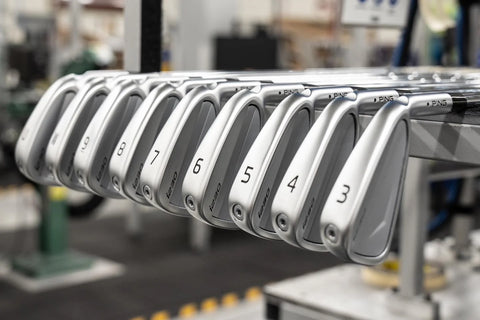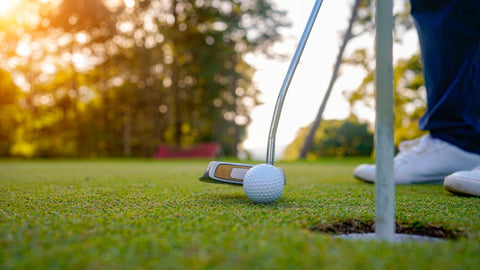There is no denying how good it feels to nail the perfect golf shot. But for beginners and seasoned golfers on the course, the right gear is essential to achieving that feeling. The perfect set of golf clubs can not only elevate your game but also improve distance, accuracy, and lower scores. With so many club options out there, it can overwhelm even the masters.
With Golf 360, we can put all those concerns to rest with our comprehensive guide on how to choose the right golf clubs. It provides you with the information you need to make informed decisions and settle on the clubs that match your swing and skills.
Let’s look at what you need to know…
Step 1: Skill Level
Honestly, one of the main points to consider when choosing a golf club is knowing your skill level. Are you a complete beginner just starting out on the driving range, or are you a skilled golfer seeking to shave strokes off your handicap?
Beginner
You’re just starting out? Focus on a forgiving set of irons with larger clubheads and a cavity back design. They’ll provide more forgiveness on those off-centre shots, allowing you to make better contact with the golf ball and build your confidence in the game! Opt for a full graphite shaft set for its lightweight feel that can help you generate more swing speed.
Scott’s top recommendation: Ping G430 Irons RH Graphite Regular
Intermediate/ Mid-Handicap
So, are you comfortable with your golf game, and has your swing developed? Take a look at including a few game-improvement irons that offer balance, forgiveness, and control. These three elements will all help you achieve a more accurate shot paired with consistent distance. Consider a mix of graphite and steel shafts depending on your swing speed and feel preference.
Scott’s top recommendation: Titleist T200
Advanced/ Low-Handicap
This is not your first introduction to the game, but it has become a way of life (we all hope to be here)! Low-handicap golfers with a powerful swing should look at forged irons, which give you maximum control and feel. They do require a high level of swing precision to enhance your performance, so be warned! Steel shafts are the standard choice for low-handicap golfers due to their better feel and responsiveness at higher swing speeds. In contrast, bladed irons offer workability, allowing you to shape shots and control ball flight.
Scott’s top recommendation: Titleist T100
Extra Tips and Decoding the Lingo
- The golfer: Height and physique play a role in picking the correct shaft length. Generally, taller players need longer shafts for better posture and swing mechanics.
- Clubhead: Material (titanium, steel) and design (cavity back, muscle back) affect forgiveness, distance, and workability.
- Shaft: Material (steel, graphite) and flex (regular, stiff) influence swing feel, power transfer, and ball trajectory.
- Shaft flex: This refers to how much the shaft bends during the swing. It’s typically categorised as Regular (R), Stiff (S), Extra Stiff (XS), and Ladies (L). A shaft that’s too stiff will lead to a loss of distance and a lower ball flight, while a shaft that’s too soft can cause the ball to balloon and lose accuracy.
- Swing speed: This is the rate of power you transfer to the golf ball upon hitting it. Knowing your swing speed (commonly measured during a fitting) helps determine shaft flex. Typically, players with a slower swing speed will benefit from a more flexible shaft (L or R flex), while players with a faster swing speed will need a stiffer shaft (S or XS flex).
- Grip: Your connection to the club! Grip size and material affect comfort and control.
Step 2: Let’s Talk Budget
Golf clubs can range in price from a few hundred dollars to several thousand. Set a realistic budget based on your needs and experience level. Beginners may be better off starting with a more affordable option and upgrading as their game improves. An excellent place to start is with a complete golf set that provides the clubs and golf bag to get you onto the course in no time. While you are here, why not check out our range of golf sets for men, womens and juniors.
For those mid-handicap players, there are an array of options with cost increases depending on the brand, technology, and fitting. Low-handicap golfers may prioritise premium materials, and for those who want performance in each club, the investment will be a bit more.
Remember, expensive doesn’t always equate to better…
Step 3: Clubhead Material
The clubhead material affects both feel and performance.
- Cast iron: Due to its softer feel and forgiveness upon off-centre hits, cast iron is a popular choice of material for some game-improvement irons.
- Titanium: You’ll find that this is the most common material used for fairway woods and drivers as it’s durable and lightweight, giving you higher ball speed and distance.
- Stainless steel: A material that occurs in irons and wedges, giving players good balance, feel, and forgiveness. Some irons may include tungsten weighting, giving the club extra stability.
Step 4: Irons
Irons are the working horse for players because of the varying distances they provide, so it’s worth mentioning these when choosing the right golf clubs.
Here’s a breakdown of iron types…
- Cavity back irons: The most forgiving choice and suitable for beginners and those high handicappers. A larger clubhead design and hollow core supports players in achieving distance.
Look at the: Ping Max G430
- Game-improvement irons: A favourite among mid-handicap golfers for balance, forgiveness, and control. Their head size is slightly smaller than the cavity-back irons’ but still delivers some forgiveness on mishits.
Look at the: Titleist T350 Graphite Irons 5-W
- Bladed irons: These irons are forged and give low-handicap golfers a more consistent swing, but they offer little forgiveness on mishits.
Look at the: Wilson Staff Model Blade Irons 2024 (4-P)
- Long irons: Or distance irons, as they suggest, are crafted for longer approach shots, prioritising distance rather than precision.
Look at: Titleist U505 Utility Iron
- Mid-irons: Or game-improvement irons give golfers a larger sweet spot, minimising mishits and are suitable for beginner and intermediate players.
Look at: Callaway Paradym Ai Smoke
- Short irons: Or player’s irons, give golfers more control and are perfect for experienced players. However, they do require a higher level of skill to hit the ball consistently upon every swing.
Look at: Titleist T100 2023 Steel Irons
Step 5: Get Fitted
Arguably, the most crucial step for any golfer is to get fitted. A professional fitting will consider things like analysing swing speed, mechanics, height, and posture. At Golf 360, we provide a golf club fitting service, and our team will adjust grip size, lie angle, loft, flex, and shaft length, as well as recommend clubs based on your needs. I highly encourage golfers of any skill level to get a personalised fitting; it will significantly improve your ball striking, control and distance, but most importantly increase your love for the game and the want to be out on the golf course daily!

FAQ
Q: How many clubs do I need in my bag?
A: A standard set has 14 clubs, but beginners may be fine with a starter set of 7-8 clubs.
Q: Can I buy individual clubs instead of a set?
A: This can be an option for experienced golfers who want to customise their golf bag. Beginners are better off with a matched set for consistency.
Q: Is it worth buying cheap golf clubs?
A: Affordable golf clubs can be a fantastic choice for beginners! They allow you to learn the game without a huge investment, and you can upgrade to better clubs as your skills improve. However, keep in mind that they may not offer the same level of performance or forgiveness as more expensive clubs.
Q: What is each golf club used for?
- Driver: This club is used for your tee shot, aiming for maximum distance to get down the fairway quickly.
- Fairway woods: They’re still great for distance on those longer shots from the fairway, but more forgiving than the driver if you don’t hit it perfectly.
- Hybrids: These are like the crossovers of the bunch. They blend the forgiveness of irons with the distance of fairway woods, making them a good alternative for beginners or off-fairway shots.
- Irons: They come in different numbers (3-iron through pitching wedge), each designed for a specific distance range. The lower the number, the longer the shot (and the harder to hit!).
- Wedges: They’ll get you close to the green and have even more loft than irons, making them ideal for those shorter, more precise shots around the green and chipping in.
- Putter: Designed to roll the ball smoothly on the putting green to sink those clutch par saves.
Q: Where can I try out different clubs?
A: Most golf shops have hitting bays or simulators where you can test clubs before you buy. At Golf 360, we are not only an in-store and online golf shop but also boast club fittings, repairs, an 18-hole putt-putt course, coaching and lessons with PGA pros, two golf simulators, and a large driving range fitted with the latest ball-tracking technology that provides insight into your gameplay and can give you a feel for the different golf clubs available.
Unleash Your Inner Champion with Golf 360
There is no trying out the game or quitting now that you are prepared and have all the information to find your perfect set of clubs. At Golf 360, we are dedicated to helping you find the ideal gear to take your golfing journey to the next level!




